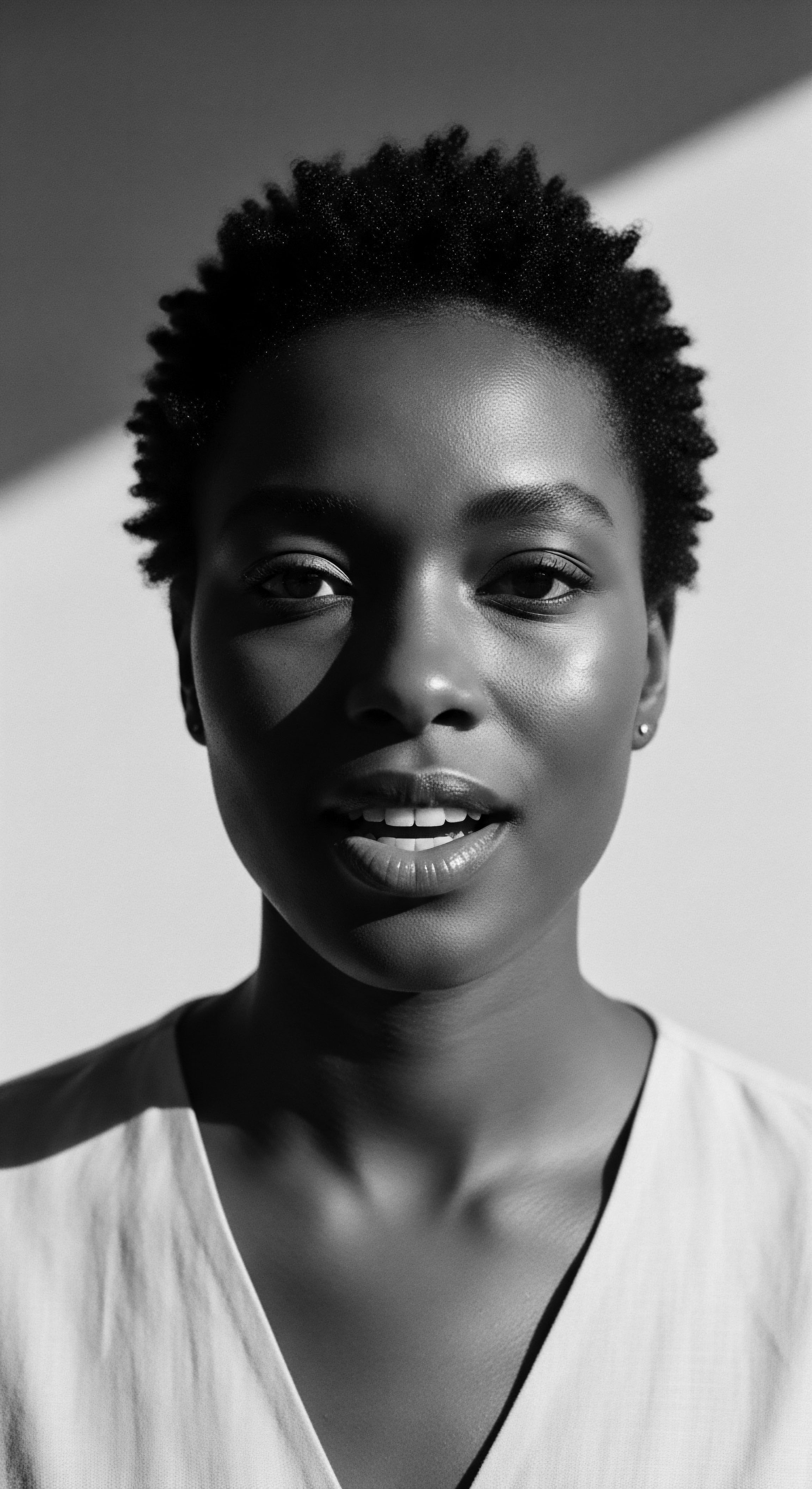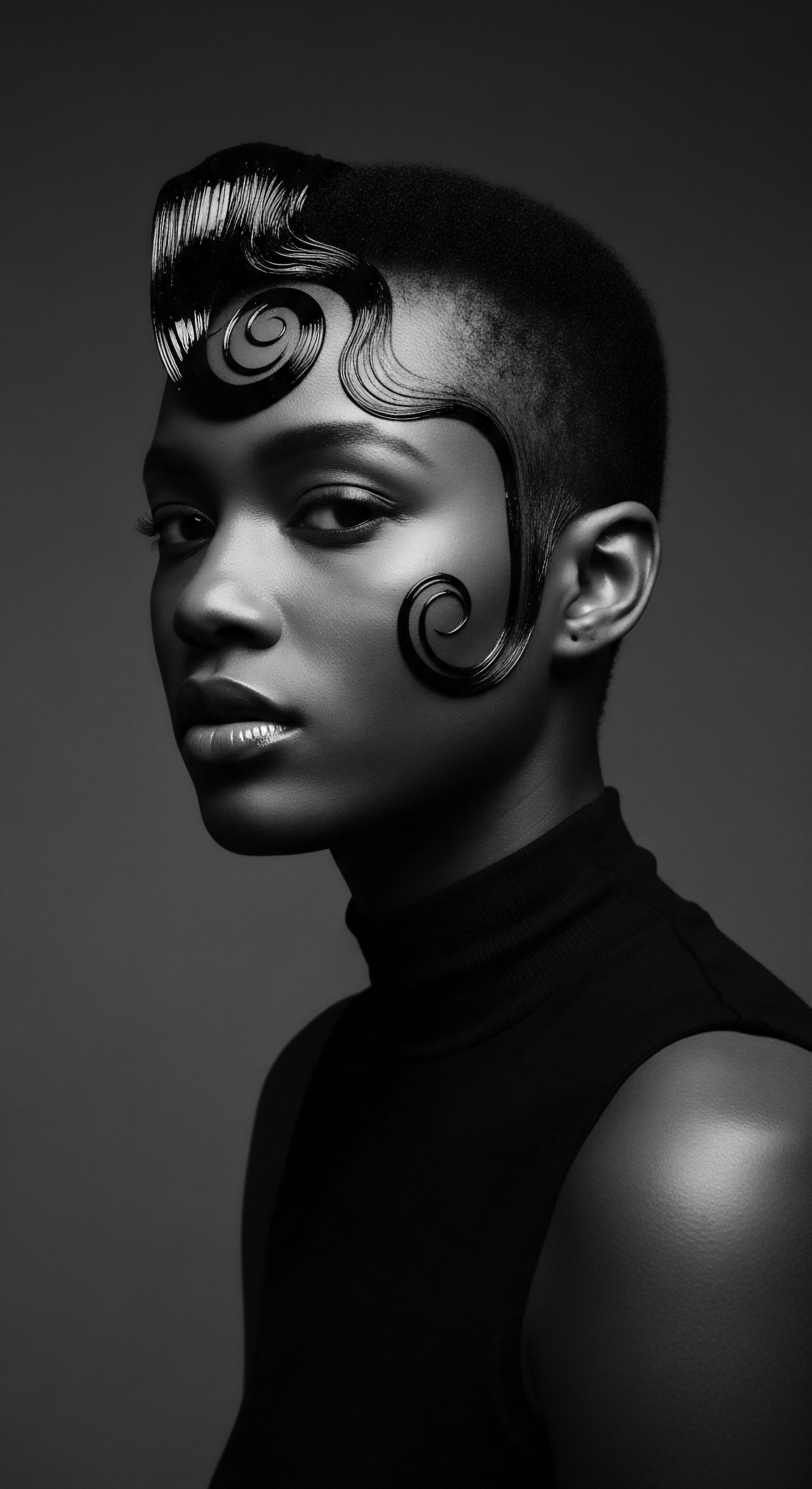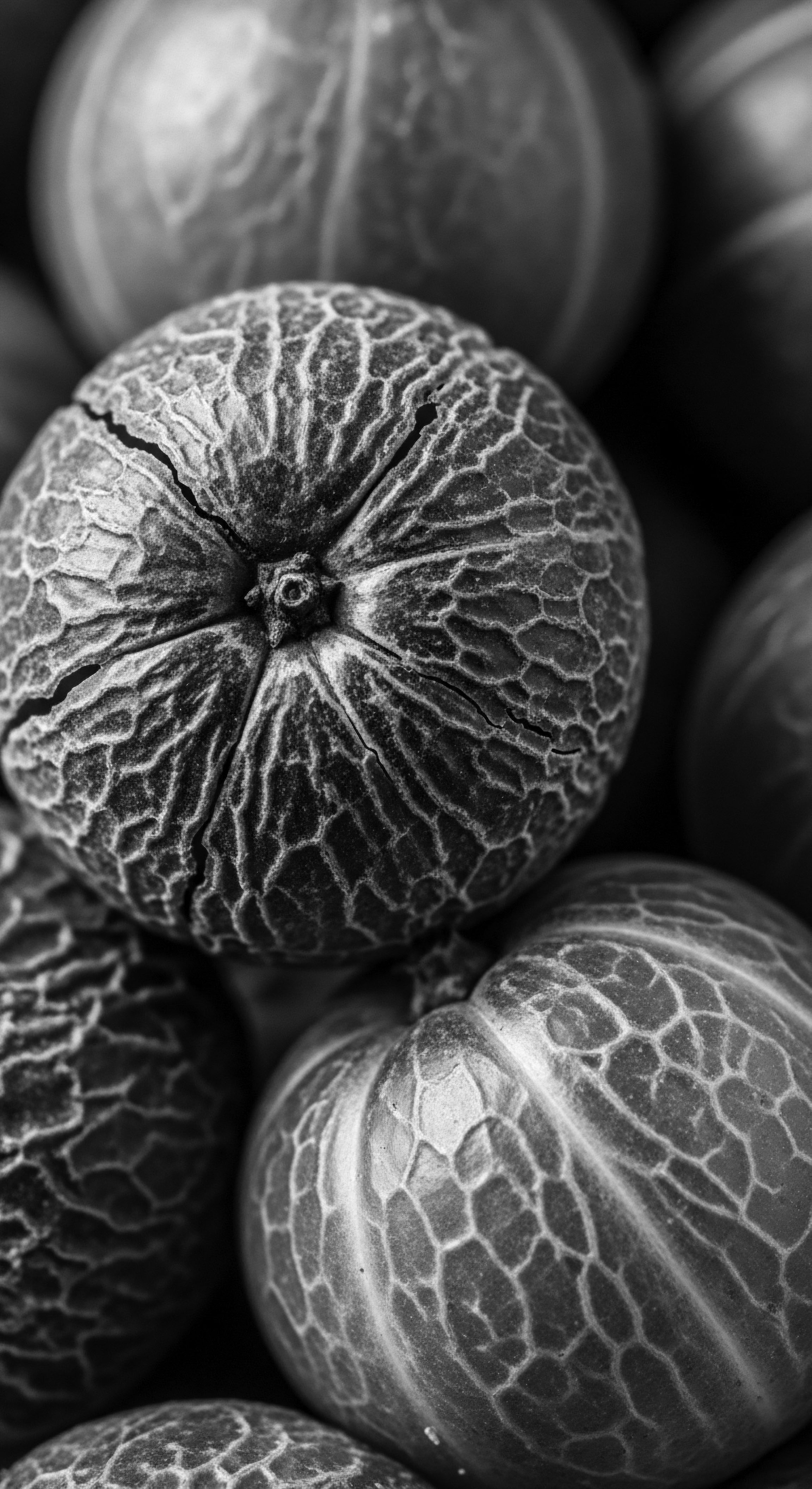
Roots
To truly comprehend how the ebb and flow of resources shapes textured hair care today, one must first journey deep into the wellspring of its existence ❉ the very fibers of the strand, the history etched within each coil and curl. It is a story not solely told in scientific treatises or product labels, but whispered through generations, carried on the winds of time from ancestral lands to contemporary salons. For those of us who carry this crown, the past is never truly past; it lives within our hair’s resilience, its demands, and its profound cultural weight.

The Intrinsic Nature of Textured Hair
The physical architecture of textured hair, from the broadest wave to the tightest coil, stands distinct. Its elliptical shaft, differing cuticle arrangements, and varied growth patterns distinguish it from other hair types. This unique form, scientists suggest, evolved over millennia as an adaptation to intense solar radiation, providing protection to the scalp. Yet, these very characteristics, which offered ancestral benefits, also present particular needs.
The spiral structure, while allowing airflow for cooling, also creates points of natural fragility along the hair shaft. Each twist and turn represents a potential site for breakage, making moisture retention a paramount concern. This inherent susceptibility to dryness means that, even in times of plenty, textured hair demands a consistent and specific regimen of hydration and gentle handling. When resources falter, these intrinsic needs become magnified, presenting formidable challenges to the vitality of the hair and, by extension, the spirit.
The inherent structural distinctions of textured hair dictate unique care requirements, making it particularly susceptible when resources become scarce.

Ancestral Understanding of Hair Anatomy
Long before microscopes unveiled the secrets of the hair follicle, African societies held an intuitive, deeply informed understanding of their hair’s nature. This understanding stemmed from centuries of observation, passed down through oral traditions and communal practices. Hair was a vital aspect of identity, spirituality, and social standing.
Communities recognized the thirst of their strands, the need for protective measures, and the gentle touch required for styling. Their wisdom, born from necessity and a deep connection to their surroundings, saw hair not merely as adornment but as a living extension of self, deserving of reverence and precise attention.
The lexicon of textured hair, too, holds roots in these ancestral understandings. Terms describing curl patterns, porosity levels, and hair states, while now standardized by modern science, often echo ancient observations of how hair responded to natural elements, how it felt to the touch, and how it draped or stood on the head. The modern classification systems, for all their precision, often fail to account for the fluidity and broad spectrum of textures that exist, or the cultural significance woven into how hair was perceived and discussed in diverse African communities. The very act of naming was an act of recognition, a celebration of variation, a practice diminished by imposed external standards that sought to flatten the rich diversity of heritage.

How Resource Availability Shapes Hair’s Understanding
Consider how resource scarcity impacted the very foundational knowledge of hair care. When populations were forcibly displaced, as during the transatlantic slave trade, not only were people severed from their communities, but also from the ancestral knowledge of their hair. The natural butters, herbs, and powders used for moisture retention and scalp health were no longer accessible.
This created a profound disruption in the transmission of haircare wisdom. Generations found themselves in new lands, facing unfamiliar climates, with their hair, a symbol of identity and communication, left matted and untended during harrowing journeys.
The scarcity of appropriate tools and natural ingredients compelled ingenuity. Individuals began to improvise, using what little they had at their disposal. This experience of making do, of adapting, is a direct ancestral lineage to contemporary resource challenges. The underlying biological needs of textured hair remained, but the traditional means of meeting those needs were severely curtailed, forcing an evolution in practices driven by absence.

Traditional Hair Elements and Their Disruption
- Chebe Powder ❉ Hailing from Chad, this blend of herbs was traditionally applied to hair to promote length retention and reduce breakage. Its use speaks to an understanding of sealing moisture.
- Shea Butter ❉ A staple across West Africa, this natural emollient provided deep conditioning and protective benefits, shielding hair from harsh elements. Its absence was acutely felt.
- African Black Soap ❉ Used for cleansing, its gentle yet effective properties made it a cornerstone of traditional washing rituals, preventing excessive stripping of natural oils.

Ritual
The act of caring for textured hair has always been more than mere hygiene; it is a ritual, a connection to self, community, and ancestry. From intricate pre-colonial African braiding patterns that spoke volumes about identity and status to the adaptive practices born of oppression, scarcity has indelibly marked the evolution of these rituals. Today, the echoes of past limitations reverberate in modern choices, shaping styling techniques and the very tools we employ.

Ancestral Stylings and Adaptive Needs
Before the disruption of forced migrations, hair styling in various African societies was an elaborate social undertaking, often serving as a visual lexicon. Braids, twists, and elaborate coiffures conveyed marital status, age, wealth, and tribal affiliation. These styles were not simply aesthetic; they were protective, designed to shield the hair from environmental elements and to facilitate length retention. The meticulous processes involved hours, often days, serving as cherished moments for community bonding, intergenerational teaching, and the transmission of cultural knowledge.
When traditional resources vanished, the deep-seated wisdom of protective styling persisted, though the materials changed. Enslaved Africans, stripped of their cultural tools and traditional ingredients, resorted to whatever was at hand. They utilized makeshift solutions such as animal fats like bacon grease or butter, and even kerosene, not for optimal hair health, but for lubrication and some semblance of manageability.
This drastic shift highlights how profound scarcity reshaped daily haircare into a practice of desperate innovation, a testament to enduring spirit even in profound deprivation. The very concept of “greasing the scalp” became a ritual of survival, a way to keep hair from becoming irrevocably matted and painful.
Hair practices for textured strands, historically rich with cultural meaning, were forced to adapt through ingenuity when ancestral resources were seized.

The Weight of Conformity and Scarcity
The post-slavery era brought new forms of scarcity ❉ a scarcity of acceptance, a scarcity of economic opportunity, and a continued scarcity of appropriate products from the dominant beauty industry. As African Americans sought integration into a society that often equated straight hair with professionalism and beauty, the demand for hair-altering techniques grew. Early chemical relaxers and hot combs offered a means to conform, to navigate a world that discriminated against natural textures.
This was not a choice born purely of preference but a response to systemic pressures and a severe lack of alternatives that celebrated and supported natural hair. The choice was often between economic and social mobility or maintaining an appearance deemed “unacceptable.”
The rise of Black entrepreneurs like Madam C.J. Walker, a true pioneer, directly addressed this void. She developed products that catered to the specific needs of Black women, recognizing both the desire for straightened styles and the fundamental need for hair health.
Her empire was a response to an unmet demand, a direct outcome of the mainstream industry’s disregard for textured hair. This historical pattern of scarcity leading to Black-led innovation remains a powerful thread in the story of textured hair care today.

Traditional Tools Reimagined
The tools of textured hair care carry their own heritage, often adapting through periods of scarcity and plenty.
| Traditional Implement Indigenous Combs |
| Ancestral Purpose and Origin Crafted from wood or bone, used for detangling and creating intricate partitions for braids. Their wide teeth respected the hair's curl pattern. |
| Adaptation Under Scarcity / Modern Counterpart During enslavement, wool carding tools were repurposed as makeshift combs, though they were harsh on hair. Modern wide-tooth combs and detangling brushes echo the gentleness of traditional designs. |
| Traditional Implement Hair Pins/Ornaments |
| Ancestral Purpose and Origin Made from natural elements, signifying status, tribe, or rites of passage, also used to secure styles. |
| Adaptation Under Scarcity / Modern Counterpart Limited availability led to less elaborate adornment. Today, specialized hairpins for textured hair provide functional and decorative elements for protective styles. |
| Traditional Implement Heated Stones/Tools |
| Ancestral Purpose and Origin Used in some cultures for gentle manipulation or setting specific styles, often with natural oils. |
| Adaptation Under Scarcity / Modern Counterpart Hot combs and pressing irons gained prominence as a means of straightening, often with damaging effects, driven by societal pressure for straight hair and a lack of other professional styling options. |
| Traditional Implement The enduring ingenuity of textured hair care is evident in how tools, from ancient combs to modern brushes, respond to evolving needs and persistent historical resource challenges. |

Relay
The practice of textured hair care today is a relay race across time, where ancestral wisdom passes the baton to modern understanding. Scarcity, in its historical and contemporary forms, has shaped every leg of this race, influencing how regimens are built, how nighttime rituals are upheld, and how hair challenges are met. The legacy of resource limitations pushes us to seek holistic solutions, connecting elemental science with profound cultural roots.

Does Scarcity of Specialized Products Still Affect Daily Regimens?
Even in an era of supposed abundance, the scarcity of truly suitable, accessible, and affordable products for textured hair remains a tangible concern for many. While a vibrant market of Black-owned brands has emerged, the shelves of mainstream retailers still often present a limited selection, particularly in certain geographic areas or at premium tiers. This perpetuates a historical cycle where consumers of textured hair must expend more effort, and often more money, to find products that genuinely cater to their hair’s unique structure and needs. The impact extends beyond mere product choice, touching the very experience of holistic well-being.
Consider the critical role of moisture in textured hair health. The spiraled nature of the hair shaft means that natural oils from the scalp struggle to travel down the entire strand, leaving it prone to dryness. In ancestral practices, this was addressed through the regular use of natural oils and butters, often locally sourced, and through protective styles that minimized exposure.
Today, the commercial market, at times, still lags in providing deeply moisturizing products without undesirable ingredients. This forces individuals to become discerning scientists and advocates for their own strands, often turning to traditional ingredients or homemade concoctions when commercial options fall short or prove too costly.

The Enduring Wisdom of Nighttime Rituals
The nighttime sanctuary, a space for restoration, holds particular importance for textured hair. The wisdom of protecting one’s hair during sleep, often with fabrics like silk or satin, has deep roots. Historically, during periods of profound scarcity and hardship, the practical need to preserve hair from tangling and breakage, especially after laborious styles, would have been paramount.
The humble bonnet, a ubiquitous tool today, carries the quiet weight of this heritage—a simple solution for a persistent need, a shield against friction and moisture loss. It speaks to a long lineage of care designed to preserve the integrity of strands against daily wear, particularly when proper cleansing and conditioning resources were scarce.
This nightly act, often a solitary one, mirrors ancestral vigilance. When access to fresh water was limited, or when the materials for daily cleansing were unavailable, protecting styled hair overnight extended its longevity and preserved precious moisture. This practice was not merely about beauty; it was about stewardship of one’s hair, a personal resource, in challenging circumstances. The contemporary choice to don a satin bonnet or rest on a silk pillowcase is a direct continuation of this ancestral ingenuity, a testament to practical wisdom passed down through generations.

How Does Scarcity Inform Problem Solving in Textured Hair Care?
The challenges faced by textured hair—breakage, dryness, scalp concerns—are amplified by resource limitations. Historically, remedies for these issues relied on the abundant natural resources of the land. Herbs, clays, and plant extracts were carefully selected for their medicinal and cosmetic properties. The scarcity imposed by colonization and displacement meant these traditional remedies were often replaced by less suitable, or even harmful, alternatives.
This historical pattern finds resonance today. When quality products are expensive or unavailable, individuals may turn to less effective or damaging alternatives. A compelling historical example that powerfully illustrates scarcity’s impact on ancestral practices can be found in the forced adaptations during American slavery. Enslaved Africans, forcibly removed from their homelands, lost access to their traditional hair care practices, including the rich array of oils, herbs, and plant-based ingredients used for centuries.
Facing severe deprivation, they resorted to readily available, albeit unsuitable, substances like animal fats, such as bacon grease and butter, and even kerosene, to lubricate and manage their hair. (Byrd & Tharps, 2001, p. 55). This drastic shift highlights a profound discontinuity in ancestral care, driven by an acute scarcity that forced improvisation with detrimental, yet necessary, consequences. This narrative serves as a poignant reminder of how resource limitation directly influenced hair health outcomes and the evolution of care practices within Black communities.
The legacy of scarcity in textured hair care has also sparked remarkable innovation within the community. When large corporations failed to serve their needs, Black entrepreneurs stepped forward, creating entire industries from the ground up. This spirit of self-reliance, born from a history of neglect, continues to drive the creation of products designed specifically for textured hair, often incorporating traditional ingredients and holistic approaches. This serves as a vital counter-narrative to historical scarcity, manifesting a future built on self-determination and communal well-being.

Ancestral Solutions for Common Hair Concerns
- Dryness ❉ Indigenous communities used oils like argan, baobab, and shea butter, applied directly or infused into hair through various methods. Today, individuals seek products rich in these same plant-derived lipids.
- Breakage ❉ Protective styles that minimized manipulation, combined with strengthening herbs and fermented rinses, were common ancestral practices to preserve length.
- Scalp Health ❉ Clays like rhassoul clay, alongside herbal infusions, cleansed and soothed the scalp, addressing issues before they escalated.

Reflection
Our exploration of scarcity’s influence on textured hair care brings us to a profound understanding ❉ the story of our hair is truly a living archive. Each strand holds not only its elemental biology but also the echoes of ancient hands, the resilience against harsh histories, and the vibrant spirit of communities determined to honor their heritage. The scarcity we discuss is not solely about missing bottles on a shelf; it speaks to deeper absences—the loss of traditional knowledge, the denial of access, the suppression of self-expression.
Yet, within this narrative of limitation, a powerful current of innovation and preservation flows. The ingenuity born from necessity, the reclamation of ancestral practices, and the relentless pursuit of holistic well-being have shaped a unique care philosophy. Our textured hair, therefore, is more than simply a collection of fibers; it is a repository of wisdom, a symbol of resistance, and a testament to enduring beauty.
It demands a mindful approach, one that looks back at the wisdom of our forebears while gazing forward with clarity, recognizing that true radiance blossoms from a place of deep respect for our past and a conscious cultivation of our present. This ongoing journey, shared across generations and continents, continues to write the vibrant, intricate story of our hair, a story of undiminished soul.

References
- Byrd, A. & Tharps, L. L. (2001). Hair Story ❉ Untangling the Roots of Black Hair in America. St. Martin’s Press.
- Dabiri, E. (2019). Don’t Touch My Hair. Penguin Books.
- Walker, A. (2002). On Her Own Ground ❉ The Life and Times of Madam C.J. Walker. Washington Square Press.
- Banks, I. (2000). Hair Matters ❉ Beauty, Power, and Black Women’s Consciousness. New York University Press.
- White, A. (2019). The History of African-American Hair ❉ From the Slave Era to the Natural Hair Movement.
- Patton, T. (2006). Our Own Kind of Beautiful ❉ Hair and Identity in African American Women. Journal of Black Studies.
- Okoro, N. (2018). Black Hair ❉ Art, Culture, History. Laurence King Publishing.
- Akbar, N. (1998). The Natural Hair Handbook ❉ A Guide to African-American Hair Care.
- Robinson, T. (2015). Hair ❉ The Story of African Hair.
- Heaton, S. (2021). “The Evolution of African Hair in America from the 17th Century to the 20th Century.” Library of Congress.
